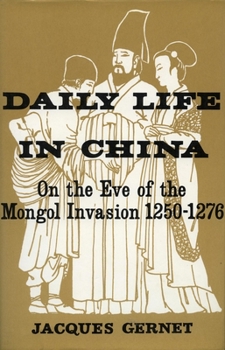Daily Life in China on the Eve of the Mongol Invasion, 1250-1276
(Part of the Daily Life Series and Daily Life Series (#7) Series)
Select Format
Select Condition 
Book Overview
A Stanford University Press classic.
Format:Paperback
Language:English
ISBN:0804707200
ISBN13:9780804707206
Release Date:June 1962
Publisher:Stanford University Press
Length:256 Pages
Weight:0.63 lbs.
Dimensions:0.7" x 5.5" x 8.5"
Customer Reviews
4 ratings
Fascinatingly detailed
Published by Thriftbooks.com User , 15 years ago
What a wonderful book! It could do with some help in the format and layout, and the sentences tend to get too long and convoluted (was that the way to write in the 1960s???) It was researched to fascinating detail, taken from various sources like artworks and documents, to give a vivid picture of the bustling life of Hangzhou during the Song period. It brilliantly covers the multi-varied life in the cosmopolitan city - food, customs, celebration, beliefs, occupations, housing, architecture, townspeople, royal family etc. An engaging read, despite the convoluted sentences. I find it fairly understandable too, the author explains things quite well, and generally doesn't presume that the readers have a lot of background to Chinese history. Not a dry read at all. I love this book.
Wonderful details
Published by Thriftbooks.com User , 17 years ago
The title of this book suggests that it is a dry account of ancient history. It is anything but; it is a fascinating account of daily life in China almost 800 years ago. As one of the other reviewers points out, one of the major themes of the book is that China changed over time, not only in response to invasions, but due to internal forces as well. A great book.
Hangzhou during the Southern Song.
Published by Thriftbooks.com User , 20 years ago
Translated from the French by H.M. Wright. The overall theme of the book is to dispel the notion of a China that was immobile, and that this lack of change is what aided in the success of the Mongol invasion. From a plethora of sources, Gernet reconstructs a snapshot of how society functioned during the end of the Southern Song dynasty (1127-1279), only a few years before the invasion. To accomplish this task the book looks at a twenty-six year period (1250-1276), focusing on the Southern Song capital, Hangzhou, and its immediate surrounding areas. Areas of exploration include Hangzhou's social makeup (the upper classes, the merchants [which had increasingly gained importance], and the lower classes) to even details on clothing, cooking, festivals, and leisure hours.The book overall is facinating in its detail and in the subject matter the author chose to explore. Many of the subjects have not been written about since, so there are still many avenues for further research. It has to be pointed out here that in light of the recent scholarly debates questioning the validity over Marco Polo's writings (see: Frances Woods, 1998 ; US News and World Report, 7/24/00), the quotes used in the book must be looked upon with this in mind. Gernet even points out that a few of the quotes he used in the book did not correspond with Chinese sources of the time (pp. 36, 47).Although Gernet shows us a glimpse of Southern Song daily life, one with any knowledge of daily life in today's China will notice certain similarities between the two. The growth in mercantilism, rural to urban mass migration, the great disparity between the rich and poor, the popularity of prostitution and other promiscuous behavior all can be found in both societies.One cannot help but walk away from a reading of this book and contemplate how China would have been today if it were not for the Mongol invasion, which halted the birth of a "modern China", centuries before the West. However, this Chinese modernization would have been far different from the West's given the way Chinese society is constructed, which has lent value to a person only within his/her social relations and has lacked any emancipation of the individual, (the cornerstone of modern Europe).
Lao's review
Published by Thriftbooks.com User , 23 years ago
This is one of my earliest and most valuable finds, an excellent resource for the study and/or reenactment of the period. The first several chapters detail city life, social classes, housing, cooking and personal grooming. The later chapters cover the broader subjects of life cycle (birth, marriage and death rituals), and the yearly cycle (festivals, religions observances). Detailed and well footnoted.






